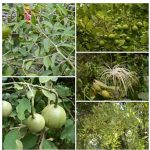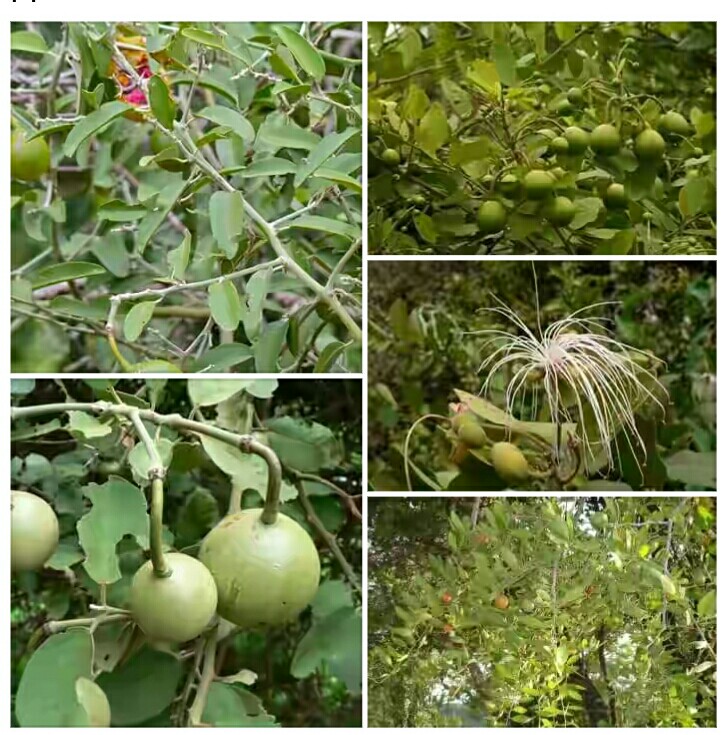Capparis tomentosa; synonyms: Capparis polymorpha, Capparis corymbifera (Scientific name) or African caper, Caper bush, Wollerige kapperbos, Woolly caper bush (English) or Ja ni baibai, Kaudodo, Ƙabdarai, Kabdodo, Ƙadabebe, Haujeri, Haujarin raƙumi, Ci zaki kabdodo (Hausa) or Ngumi daleewi (Fula-Fulfulde) or Zaji (Kanuri) or Fwi (Berom) or Kpalkpal (Bogghom): A poisonous but medicinally useful tree
DESCRIPTION AND OCCURRENCE
Capparis tomentosa is a spiny, much-branched shrub or small tree, with an upright trunk and climbing, pubescent branches. Leaves are elliptic, elliptic-oblong or ovate, 26-70 mm long and 13-80 mm wide, with tips usually round with a sharp point, light green to greyish green, soft and velvety. Hooked and sharp spines are found in the axils of the leaves. Flowers are fragrant with pale yellowish green petals, that surround a tuft of white or pink stamens, that grow up to 30 mm long.
The flowers develop into red, globose, pendulous (hanging) fruits, which grow up to 50 mm in diameter. Seeds are dark brown, ovoid to kidney shaped and 1-15 mm long. The seeds are surrounded by a juicy, white to pinkish pulp. In South Africa, the plants flower in spring and early summer, from August to November. Flowers open in the morning and start to fade in the middle of the day. Fruits are produced in summer, from December to March.
The plant grows in arid, sandy plains, mountain slopes, forests, river banks and coastal bush. Capparis tomentosa prefers to grow on ant hills in deciduous bushlands and woodland savannas. Capparis is the Latin word for the edible fruit of a caper bush. The species name tomentosa is derived from the Latin word tomentosa, meaning ‘woolly’. This describes the woolly coat formed by closely pressed hairs on the leaves. Capparis tomentosa is widespread, from Mauritania, Senegal and Gambia eastward to Eritrea and Ethiopia, and southward to north-eastern South Africa and Swaziland. It also occurs in southern Arabia.
Health Benefits and Medicinal uses
The fruits are eaten by some people and monkeys, but they are regarded as poisonous. The plant is often planted as a barrier hedge. This plant is a good one bee-keepers to plant as the flowers attract honey bees and therefor it is important for the production of honey.
The plant is an important food source for Lepidoptera species (moths and butterflies), as they feed on a narrow variety of plant during their larval stages. It has been reported that the leaves are eaten as a vegetable after cooking in times of food shortage. The foliage is browsed by camels and goats, although it has been recorded as toxic to most livestock.
Poisoning of donkeys after browsing Capparis tomentosa plants has been reported in northern Kenya, and poisoning of cattle, sheep, goats and camels in Sudan, resulting in hydrothorax, hydropericardium and ascites.
On the other hand, overbrowsing of Capparis tomentosa by goats has been reported near human settlements in Uganda without adverse effects, and in Tanzania Capparis tomentosa has been recorded as one of the favourite browse species for zebu cattle. Fatal accidents have been reported for some patients who had taken medicines based on Capparis tomentosa roots.
Although various plant parts of Capparis tomentosa have been reported to be toxic, particularly the roots, they are widely used in traditional medicine throughout the distribution area of the species.
Root powder and root decoctions are taken to treat rheumatism, colds, cough, tuberculosis, apoplexy, stomach complaints, diarrhoea, rectal prolapse, schistosomiasis, gonorrhoea, syphilis, leprosy, endometritis, menorrhagia, sterility and threatened abortion, and as anodyne, diuretic, anthelmintic and poison antidote.
Grounded or powdered roots are applied to wounds, swellings, abscesses and snakebites, and to treat headache, migraine, skin diseases and eye complaints including conjunctivitis, ophthalmia and cataract. Root decoctions are added to baths against haemorrhoids. The smoke of burning bark powder is inhaled to treat tuberculosis, bronchitis and chest pain. Leaf decoctions are applied to treat skin diseases and wounds, and are taken to treat hepatitis, malaria, convulsions, angina, venereal diseases, asthma and leprosy.
Root macerations are given to cattle to treat diarrhoea, whereas a paste made of root ash is applied to udder inflammations. The roots have been used in the preparation of arrow poison and in meat to poison animals. Capparis tomentosa is one of the best known woody species with magico-medicinal properties, and it is commonly used in ritual ceremonies. The press-cake made from the seeds is fed to cattle. Stems and branches are used as firewood. Cut branches are sometimes planted to make life fences. It is also a decorative plant for gardens.
Capparis tomentosa is an important medicinal plant in many indigenous communities throughout South Africa. The roots play a vital role in sexual and reproductive health. They are used to cure HIV opportunistic infections, such as tuberculosis, Herpis zoster and Herpes simplex and chronic diarrhoea. The roots are also used as an infusion to assist with sterility, threatened abortion, gonorrhoea, syphilis and also to stop bleeding after childbirth.
In South Africa, other plant parts also play an important role in traditional medicine. Decoctions of the roots, leaves and bark can be used to treat coughs, fever, and asthma.
Treatment should be taken in small quantities, as large doses can cause toxicity to the patient. Powdered roots can also be applied to wounds, abscesses and snakebites. The smoke inhaled from burning powdered bark, can be used for bronchitis, chest pains and headaches.

FOR FURTHER READING SEE:
1. Arbonnier, M., 2004. Trees, shrubs and lianas of West African dry zones. CIRAD, Margraf Publishers Gmbh, MNHN, Paris, France. 573 pp.
2. Aweke, G. 2013. Capparis tomentosa Lam. In G.H. Schmelzer & A. Gurib-Fakim (eds). Prota 11 (2): Medicinal plants/Plantes médicinales 2. PROTA, Wageningen, Netherlands.
3. Burkill, H.M., 1985. The useful plants of West Tropical Africa. 2nd Edition. Volume 1, Families A–D. Royal Botanic Gardens, Kew, Richmond, United Kingdom. 960 pp.
4. Chinsembu, K.C. & Hedimbi, M. 2010. An ethnobotanical survey of plants used to manage HIV/AIDS opportunistic infections in Katima Mulilo, Caprivi region, Namibia. Journal of ethnobiology and ethnomedicine 6 (1), 1.
5. van Wyk, B.E., van Oudtshoorn, B. & Gericke, N., 1997. Medicinal plants of South Africa. Briza Publications, Pretoria, South Africa. 304 pp.
Sa’eed Halilu Bawa
Senior Lecturer (Associate Professor) at University of the West Indies, St. Augustine Campus, Trinidad.
Studied Food and Nutrition Sciences, Dietetics at Kaduna Polytechnic, Nigeria; Warsaw University of Life Sciences, Poland.
























